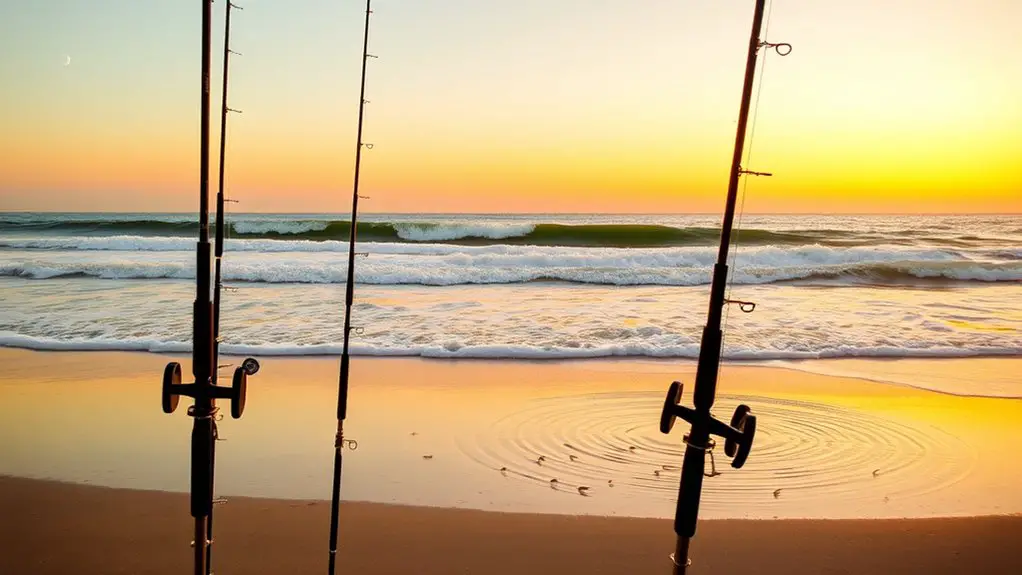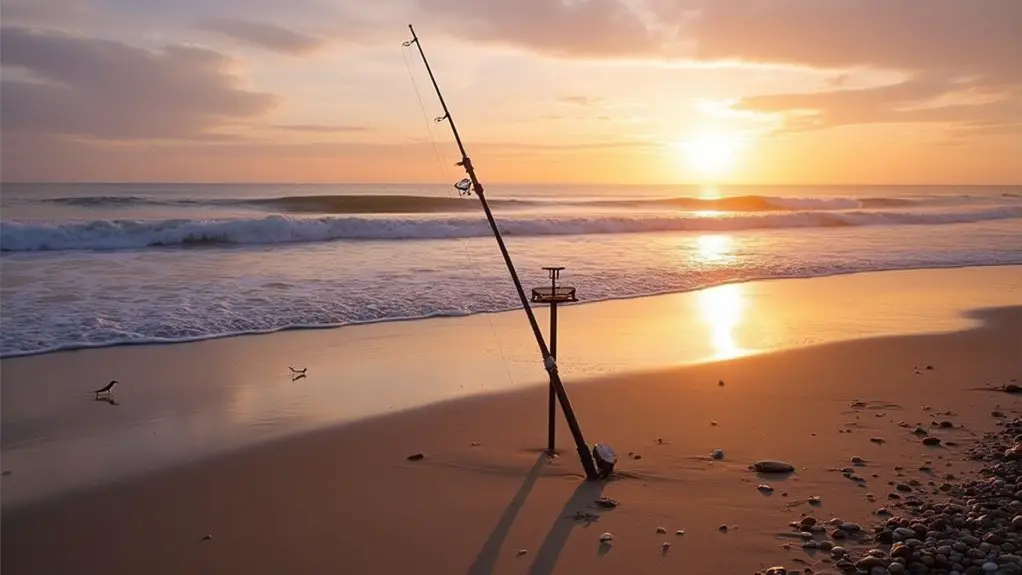The most productive surf fishing happens during “golden hours” at dawn and dusk, especially when aligned with tide changes. Your best bet is the “magic hour”—one hour before high tide and the first hour of falling tide—when feeding activity surges (42.3% better catches on incoming tides). The rule of twelfths suggests targeting the 3rd and 4th hours of tidal movement when 50% of water flows. Full moons enhance night fishing while new moons improve dawn/dusk sessions. Discover how weather patterns can turn an ordinary outing into a memorable catch.
Surf Fishing Highlights
- Dawn and dusk are prime fishing times when predatory fish are most active in low-light conditions.
- Fish feeding activity peaks during the “magic hour”—one hour before high tide and first hour of falling tide.
- Incoming tides generally yield better catch rates (42.3% correlation) as they bring baitfish closer to shore.
- Target the 3rd and 4th hours of a tide cycle when 50% of water flows, creating optimal feeding conditions.
- Moon phases significantly impact fishing success, with full and new moons generating stronger tides and increased activity.
The Magic of Dawn and Dusk: Why These Hours Outperform Others
While many anglers pack up their gear when the sun climbs high in the sky, they’re missing out on what seasoned surf fishermen know as the “golden hours.”
Dawn and dusk represent magical windows of opportunity when fish feeding activity surges dramatically.
During these shifting periods, you’re witnessing nature’s perfect storm of feeding advantages. Predatory fish use the dim light as cover to ambush prey, while smaller species feel protected enough to become active. Many species like snapper will move into shallow waters![]() during dusk hours, creating prime fishing opportunities. Fish feed better in low light conditions
during dusk hours, creating prime fishing opportunities. Fish feed better in low light conditions![]() , making these transition times ideal for maximizing your catch. Big game fish like tuna are frequently caught trolling at dawn
, making these transition times ideal for maximizing your catch. Big game fish like tuna are frequently caught trolling at dawn![]() or during the evening transition.
or during the evening transition.
Nature’s twilight dance – where predators find their advantage and prey finds false security.
Your terminal tackle becomes nearly invisible, reducing fish suspicion. It’s a changing of the guard – diurnal species giving way to nocturnal hunters, with both groups feeding aggressively during the overlap.
Understanding Moving Tides: Incoming vs. Outgoing Success Rates
Because fish respond dramatically to water movement, understanding the difference between incoming and outgoing tides can transform your surf fishing success.
Incoming tides typically yield better results, with studies showing a 42.3% positive correlation to catch rates along the Upper South Coast. Why? Rising water carries baitfish shoreward, creating a buffet for predatory species.
Don’t dismiss outgoing tides, though! They concentrate fish in channels and flush tasty morsels from estuaries. Experienced anglers have found that the full moon week![]() often produces exceptional flounder catches during these tidal movements.
often produces exceptional flounder catches during these tidal movements.
The real secret isn’t just high or low tide—it’s the current. Many anglers miss prime fishing opportunities by not recognizing that tide and current![]() differ significantly in how they affect fish behavior. Using the Rule of Twelfths, you’ll identify peak water movement periods when fish are most active and hungry. The strongest water movement
differ significantly in how they affect fish behavior. Using the Rule of Twelfths, you’ll identify peak water movement periods when fish are most active and hungry. The strongest water movement![]() occurs during the middle third of the tidal cycle, making this an optimal time for catching fish.
occurs during the middle third of the tidal cycle, making this an optimal time for catching fish.
Mastering the Rule of Twelfths for Peak Feeding Times
Three critical hours separate the anglers who consistently catch fish from those who go home empty-handed.
It’s all about mastering the Rule of Twelfths, nature’s fishing clock.
This simple formula divides the six-hour tidal cycle into predictable movements: 1/12, 2/12, 3/12, 3/12, 2/12, and 1/12 of total tidal change.
You’ll want to target those middle hours (3rd and 4th), when water moves fastest at 3/12ths each hour.
That’s when baitfish get disoriented and predators feast!
Understanding these patterns remains critical for safety![]() when fishing from shorelines with significant tidal ranges.
when fishing from shorelines with significant tidal ranges.
During these peak periods, approximately 50% of tide![]() flows in, creating prime conditions for aggressive feeding behavior.
flows in, creating prime conditions for aggressive feeding behavior.
Local geography and coastal features can alter tidal patterns![]() significantly, so always adjust your fishing strategy to match the specific conditions of your location.
significantly, so always adjust your fishing strategy to match the specific conditions of your location.
Lunar Influence: How Moon Phases Drive Fish Behavior

Just as tides follow predictable patterns, the moon silently orchestrates fish behavior beneath the waves.
You’ll notice significant changes in surf fishing success depending on lunar phases, with full and new moons triggering the most intense feeding activity due to stronger tidal movements.
For maximum success, remember these lunar fishing strategies:
- Target the hours surrounding moonrise and moonset, when gravitational shifts stimulate fish movement.
- Fish night sessions during full moons when predatory species have improved visibility.
- Focus on dawn/dusk during new moons when fish rely less on sight and more on other senses.
Different species respond uniquely to lunar influences, so track your catches alongside moon phases! The moon cycle lasts![]() approximately 29.5 days, giving you predictable windows to plan your fishing trips. Many anglers report catching big game fish
approximately 29.5 days, giving you predictable windows to plan your fishing trips. Many anglers report catching big game fish![]() just before or after full moon periods, creating prime opportunities for trophy catches. The Solunar Theory suggests that the major feeding periods occur when the moon is directly overhead or underfoot
just before or after full moon periods, creating prime opportunities for trophy catches. The Solunar Theory suggests that the major feeding periods occur when the moon is directly overhead or underfoot![]() .
.
Weather and Environmental Factors That Trigger Feeding Frenzies
While lunar cycles provide predictable patterns for surf fishing success, nature’s more dramatic weather events often spark the most memorable feeding frenzies. You’ll notice fish become particularly active when barometric pressure drops before storms, creating perfect ambush conditions. Nor’easters and hurricanes are especially effective at stimulating bass and blues to feed more aggressively. Overcast days![]() can significantly improve your surf fishing results as fish tend to be less cautious and more willing to venture into shallower waters. Fish growth and feeding patterns are significantly influenced by water temperature
can significantly improve your surf fishing results as fish tend to be less cautious and more willing to venture into shallower waters. Fish growth and feeding patterns are significantly influenced by water temperature![]() , with higher temperatures typically increasing feeding activity in juvenile fish while potentially limiting adult fish in warmer months.
, with higher temperatures typically increasing feeding activity in juvenile fish while potentially limiting adult fish in warmer months.
| Weather Condition | Fish Behavior | Best Fishing Approach |
|---|---|---|
| Approaching Storm | Aggressive feeding | Cast near structure edges |
| Dawn/Dusk | Surface activity | Use topwater lures |
| After Rain | Baitfish displacement | Target runoffs and channels |
| Windy Days | Increased oxygenation | Fish the windward shore |
| Temperature Shifts | Shifting movement | Follow thermoclines |
Practical Planning: Combining Time, Tide and Season for Maximum Catches
To become a truly skilled surf angler, you’ll need to master the art of coordinating multiple natural factors that influence fish behavior.
Success hinges on understanding how tide, time of day, and season interact to create prime fishing windows.
For maximum catches, follow these proven strategies:
- Target the “magic hour” – fish an hour before high tide and continue through the first hour of falling tide.
- Synchronize dawn/dusk outings with favorable tide phases whenever possible.
- Adjust your approach seasonally, fishing deeper channels during winter and shallower sandbars during summer.
- Check local tide tables
 for your specific location, as tide times can vary significantly by area.
for your specific location, as tide times can vary significantly by area. - Monitor wave height
 carefully, as the optimal 0-2 foot conditions provide the best environment for productive surf fishing.
carefully, as the optimal 0-2 foot conditions provide the best environment for productive surf fishing. - Consider fishing during the ideal swell interval
 of 10 seconds or more for the best results.
of 10 seconds or more for the best results.
Frequently Asked Questions
How Long Should I Fish During Each Prime Tide Window?
For maximum success, you’ll want to fish 2-3 hours during the incoming tide (prime time!), arriving 30-60 minutes before it starts.
The first half of the incoming tide often delivers the best action. During high tide slack, limit yourself to 30-60 minutes when water movement slows.
Outgoing tides can be productive for 1-2 hours post-high tide. Low tide periods? They’re typically less fruitful, but specific spots might warrant a 1-2 hour session.
Do Different Fish Species Respond Differently to Tide and Time Factors?
While the night conceals and the tides reveal, you’ll find fish species responding dramatically differently to these factors.
Your target matters! Predatory species like stripers often ambush prey during moving tides, especially at dawn or dusk.
Bottom-feeders, meanwhile, don’t care much about light but love the stirred-up seafloor during strong currents.
Summer shifts many species to nighttime feeding patterns, while winter keeps them active in daylight.
Learning these species-specific patterns will dramatically improve your catch rate!
What’s the Best Surf Fishing Approach During Slack Tide Periods?
During slack tide, you’ll want to target structure-rich areas like passes, jetties, and drop-offs where fish concentrate as currents weaken.
Lighten your terminal tackle since you don’t need heavy weights fighting current. Try slow, varied retrieves with occasional pauses and rod tip pops to mimic injured prey.
Remember, these windows are brief (just 20-30 minutes), so be mobile and ready to shift locations.
For the best results, combine slack tide fishing with dawn or dusk periods when fish are naturally more active.
How Do Artificial Lights Affect Nighttime Surf Fishing Success Rates?
Artificial lights dramatically boost your nighttime surf fishing success by attracting various marine species to your fishing zone.
You’ll find cyan LED lights outperform white ones, penetrating water more effectively while using less energy. They’re like underwater magnets for shrimp and small fish!
However, be strategic with light intensity and color—you can actually target specific species while reducing unwanted bycatch.
Just remember, these lights alter natural predator-prey dynamics, so use them responsibly to avoid disrupting local ecosystems.
Can Barometric Pressure Changes Predict Better Surf Fishing Conditions?
Yes, barometric pressure changes can definitely predict better surf fishing conditions.
You’ll often find that a falling barometer (below 29.8 inHg) can trigger feeding frenzies as storms approach, stirring up nutrients along the shoreline.
When pressure stabilizes after a storm, that’s your golden window! Fish in deeper water won’t react as dramatically, though.
Conclusion
Like a skilled conductor timing each instrument’s entry perfectly, you’ll maximize your surf fishing success by synchronizing dawn, dusk, and tide movements. You’ve now got the knowledge to read nature’s cues, understand the rule of twelfths, and plan around lunar phases. By combining these elements with seasonal patterns and weather conditions, you’re no longer just fishing—you’re strategically harvesting the ocean’s bounty when the odds are stacked in your favor.

